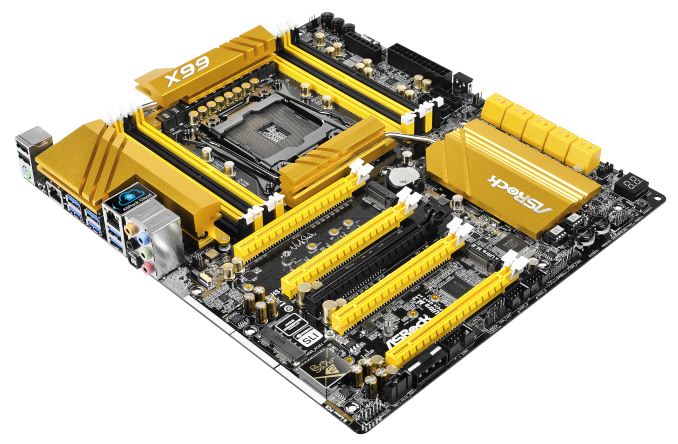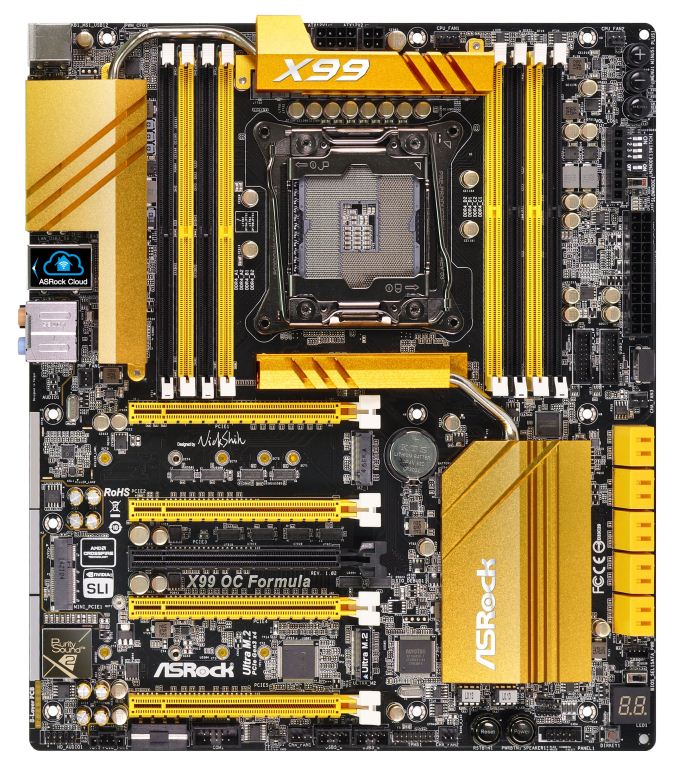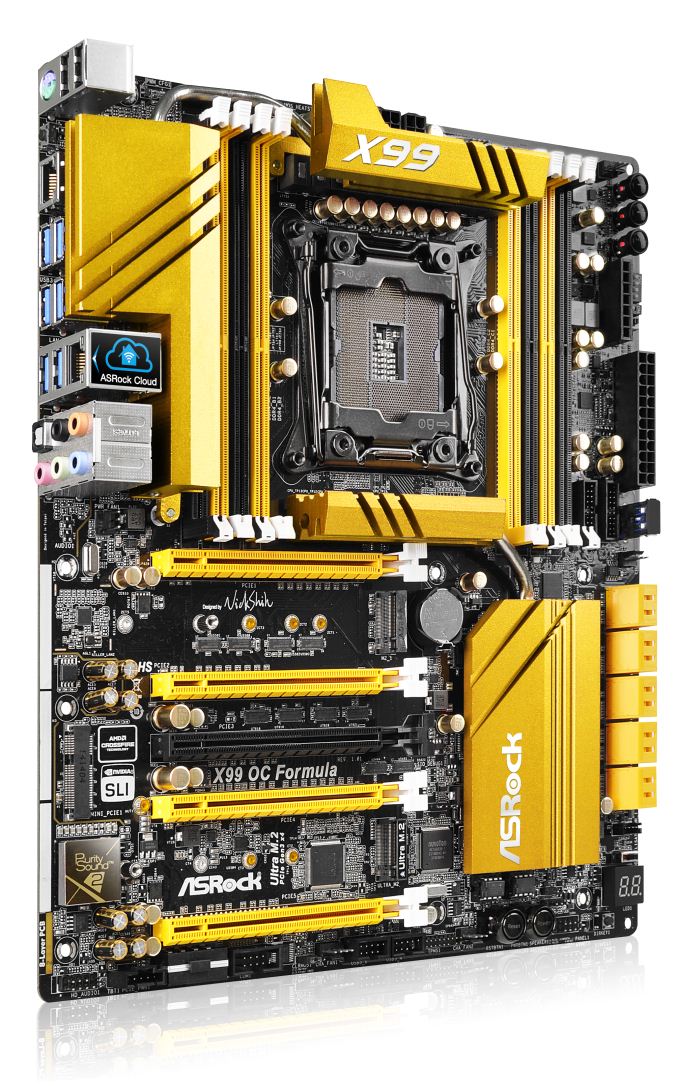Exclusive: ASRock’s X99 OC Formula Motherboard in Pictures
by Ian Cutress on August 25, 2014 6:20 AM EST- Posted in
- Motherboards
- Intel
- ASRock
- Overclocking
- X99

To add another element to the current whirlwind of X99 motherboard shots being released, ASRock has now lifted the lid on its high end overclocking motherboard, the X99 OC Formula. Similar to other OC Formula motherboards, this model is designed by ASRock’s in-house overclocker former world #1 Nick Shih. With the yellow and black livery, ASRock is keen to promote its use of 12 power phases capable of supporting up to 1300W. While regular users will come nowhere near to 1300W, extreme overclockers have (with previous platforms) hit 500W-700W while using liquid nitrogen to push the processors. Given ASRock’s recent push for overclocking records, it makes sense to design a product that can compete. Alongside this feature, ASRock still wants to have a motherboard that regular end-users can use 24/7 with high-end overclocks.
Alongside the new socket, the motherboard will offer 8 DIMM slots and 10 SATA 6 Gbps ports. Instead of SATA Express it looks like there is two M.2 slots, one PCIe 2.0 x4 (sharing lanes with the black slot) and one PCIe 3.0 x4, both supporting up to 110mm drives. Next to the Purity Sound 2 is a half-height mini-PCIe slot, suggesting that there may be a WiFi edition or users can add their own WiFi module. The PCIe slots should allow 4-way Crossfire and SLI, with a central PCIe slot (PCIe 2.0 x4?) that will allow an additional PCIe card for two-way setups.
For overclockers, the X99 OC Formula will have the superhydrophobic Conformal Coating similar to previous models that protects the components on the motherboard from moisture. On the top right of the motherboard are quick frequency change buttons along with voltage check points, a PCIe disable switch, an LN2 mode switch and a slow mode switch. On the rear panel is a ClearCMOS switch, and additional PCIe power is provided by a molex connector.
For regular home users, there are six fan headers, a Thunderbolt header (requires a Thunderbolt PCIe card), a COM header, two USB 2.0 headers, a TPM header and two USB 3.0 headers. There are 10 USB 3.0 ports total including the two headers, and the rear IO shows dual network ports. The connector on the right hand side under the SATA ports is for ASRock's relatively new SATA power feature that makes use of hot-plug functionality to hide drives not in use. I would imagine that the ASRock BIOS and Software are also receiving iterative updates, and the in-the-box contents for OC Formula models in the past have always been interesting. With X99 being an expensive platform by comparison to Z97, I hope that there can be something in there to tantalize everyone.
With all the X99 press shots floating around the media, along with DDR4 pricing going live for pre-orders, things are getting more and more exciting. No word if the ASRock X99 OC Formula will be available at launch, or the release pricing, but I am sure we will know in due course.













33 Comments
View All Comments
zodiacfml - Monday, August 25, 2014 - link
it is because some people ask for it.ShieTar - Monday, August 25, 2014 - link
Also, I'm sure ASrock desing new boards by starting with old designs and changing everything that needs to change. Removing the PS/2 would actually cost them a few hundred dollars worth of designer working hours, and probably reduce the manufacturing cost by less than a cent. And I don't see them selling millions of X99 boards.extide - Monday, August 25, 2014 - link
No, it wouldn't man, removing the PS/2 port would take no more than 5 minutes in their PCB design program. It's a non issue. It's there because they want it there.hojnikb - Monday, August 25, 2014 - link
Yep. Its there because either there is still demand for it or they just didn't bother removing it.Gigaplex - Monday, August 25, 2014 - link
They wouldn't even need to do that. They'd just simply not solder the PS/2 port onto the motherboard even if the PCB supports it.ShieTar - Tuesday, August 26, 2014 - link
I've been working as an engineer for a good decade not, and I can assure you that absolutely nothing takes 5 minutes when it comes to industrial products. Once you are done changing the design files, the documentation, the ordering system, the assembly procedures, etc. you also need everything reviewed by the corresponding design authorities, I ensure you that at least 10 man-hours are spent. Hell, just a two-hour discussion of 5 people on the potential drawbacks of removing the port can take two hours and waste the 10 man-hours before anything is changed at all.khanov - Monday, August 25, 2014 - link
Ignoramus.Samus - Monday, August 25, 2014 - link
I run into n-key rollover issues all the time. Once you start typing >80wpm USB shows its limitations. It's also obvious in games like BF4 where pressing 4-5 keys simultaneously isn't uncommon. You need to read about the advantages of PS/2's polling rate before making such assumptions. Even serial ports have their function. It isn't useless like a parallel port or something...scootd - Tuesday, August 26, 2014 - link
If you have ever had to use a computer that had a usb driver fail then you'll know why they keep them their. It is a driver less port so when shit hits the fan you dont have to re-install the OS just to use your keyboard.boogerlad - Monday, August 25, 2014 - link
I am not so sure if PS/2 is lower latency. It has to go through the super-io chip, followed by the southbridge, while USB is just going through the southbridge(native).